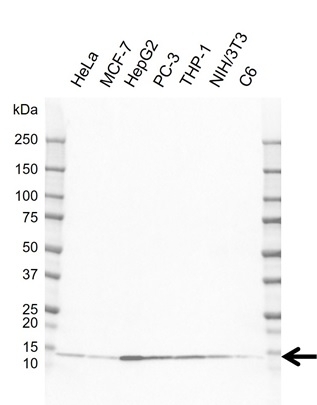SEC61B antibody | rAB01-4H3

Mouse anti SEC61B
- Product Type
- PrecisionAb Monoclonal
- Clone
- rAB01-4H3
- Isotype
- IgG2a
- Format
- Purified
- Specificity
- SEC61B
| Mouse anti SEC61B antibody recognizes protein transport protein Sec61 subunit beta. SEC61B is a component of the Sec61 translocon (Chiusa et al. 2019), a complex in the endoplasmic reticulum (ER) that mediates membrane insertion of membrane proteins of organelles associated with endocytosis and exocytosis (Lang et al. 2017). The gene encoding SEC61B is associated with polycystic liver diseases, a group of inherited disorders characterized by multiple hepatic cysts (Cornec-Le Gall et al. 2018; Lee-Law et al. 2019). |

|
- Target Species
- Human
- Western Blotting
- Mouse anti SEC61B antibody detects a band of approximately 12 kDa in HepG2 cell lysates
- Species Cross-Reactivity
-
Target Species Cross Reactivity Mouse Rat - N.B. Antibody reactivity and working conditions may vary between species.
- Product Form
- Purified IgG - liquid
- Preparation
- Recombinant IgG prepared by affinity chromatography on Protein A from cell culture supernatant
- Source
- CHO-S
- Buffer Solution
- Phosphate buffered saline
- Preservative Stabilisers
- 0.09% Sodium Azide (NaN3)
- Immunogen
- E. coli--derived recombinant protein of amino acids 2-70 of human SEC61B
- Approx. Protein Concentrations
- IgG concentration 1.0 mg/ml
- Regulatory
- For research purposes only
- Guarantee
- As supplied, 12 months from date of despatch
- Acknowledgements
- PrecisionAb is a trademark of Bio-Rad Laboratories
| Application Name | Verified | Min Dilution | Max Dilution |
|---|---|---|---|
| Western Blotting | 1/2000 |
- UniProt
- P60468
- Entrez Gene
- SEC61B
- GO Terms
- GO:0000060 protein import into nucleus, translocation
- GO:0016021 integral to membrane
- GO:0030433 ER-associated protein catabolic process
- GO:0030970 retrograde protein transport, ER to cytosol
- GO:0031205 endoplasmic reticulum Sec complex
- GO:0048408 epidermal growth factor binding
- GO:0055085 transmembrane transport
VMA00905
If you cannot find the batch/lot you are looking for please contact our technical support team for assistance.
Please Note: All Products are "FOR RESEARCH PURPOSES ONLY"
View all Anti-Human ProductsAlways be the first to know.
When we launch new products and resources to help you achieve more in the lab.
Yes, sign me up